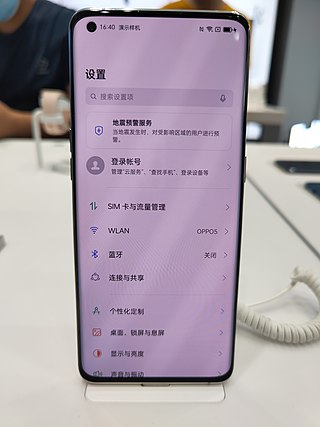Oppo phones are smartphones produced by the partially state-owned Chinese company Oppo, running in several countries.
The Vivo NEX 3 and Vivo NEX 3 5G are Android phablets developed by Vivo which were unveiled on 16 September 2019.
The OnePlus 7T and 7T Pro are Android-based smartphones manufactured by OnePlus. The 7T was unveiled on 26 September 2019, and the 7T Pro was unveiled on 10 October 2019. The McLaren edition from the 6T returns on the 7T Pro. Both have minor upgrades as with previous T phones, such as new software, upgraded cameras and a faster chipset.
The Xiaomi Mi CC9 Pro is an Android smartphone developed by Xiaomi. It is the world's first commercially available phone with a 108 MP primary camera.
Redmi K30 is a line of Android-based smartphones manufactured by Xiaomi and marketed under its Redmi sub-brand. There are two main models, the K30 and the K30 5G. A rebranded version of the K30 was later announced for India as the POCO X2, followed by the K30 5G Speed, which has a faster version of the K30 5G's chipset, and the K30i 5G which has a lower resolution camera sensor.

The Xiaomi Mi 10 and Xiaomi Mi 10 Pro are Android smartphones developed by Xiaomi Inc. announced on 13 February 2020.

The LG V60 ThinQ 5G, commonly referred to as the LG V60, is an Android phablet manufactured by LG Electronics as part of the LG V series. It was announced in February 2020 and is the successor to the LG V50 ThinQ. On April 5, 2021 LG announced it will be shutting down its mobile phone division and ceasing production of all remaining devices. LG noted the phone will be available until existing inventory runs out.
The Oppo Find X2 and Find X2 Pro are Android-based smartphones manufactured by Oppo, unveiled on 6 March 2020.

Redmi K30 Pro is a line of Android-based smartphones manufactured by Xiaomi and marketed under its Redmi sub-brand. There are four models, the K30 Pro, K30 Pro Zoom, K30 Ultra and the POCO F2 Pro, which is a rebranded version of the K30 Pro.
The Motorola Edge (2020) and Edge+ (2020) are Android smartphones developed by Motorola Mobility, a subsidiary of Lenovo.

The Samsung Galaxy Note 20 and Galaxy Note 20 Ultra are a series of high-end Android-based phablets designed, developed, produced, and marketed by Samsung Electronics as part of their Samsung Galaxy Note series, succeeding the Samsung Galaxy Note 10 series. The phablets were announced on 5 August 2020 alongside the Samsung Galaxy Z Fold 2, Galaxy Watch 3, Galaxy Buds Live and Samsung Galaxy Tab S7 during Samsung's Unpacked Event. It was the final model in the Galaxy Note series, with Samsung beginning to integrate the functionality from the Note series into its S series "Ultra" models, starting with the Galaxy S20 Ultra.

The Xiaomi Mi 10 Ultra is an Android-based high-end smartphone developed by Xiaomi Inc. announced on 11 August 2020 as a celebration of Xiaomi's 10th anniversary. Unlike the Mi 10 and Mi 10 Pro, Mi 10 Ultra is only available on the Chinese market.

The Sony Xperia 5 II is an Android smartphone marketed and manufactured by Sony Mobile. Part of Sony's flagship Xperia series, the phone was announced on September 17, 2020. A less expensive and more compact variant of the Xperia 1 II, the Xperia 5 II belongs to Sony's handset lineup of 2020, which includes the flagship Xperia 1 II and the entry-level Xperia 10 II. The phone was released worldwide in October 2020.

The Xiaomi Mi 10T, Xiaomi Mi 10T Lite and Xiaomi Mi 10T Pro are Android-based smartphones developed by Xiaomi Inc. announced on 30 September 2020, while the Xiaomi Mi 10i, which is based on Mi 10T Lite but with a 64 MP camera, was announced on 5 January 2021.
The Samsung Galaxy A72 is a mid-range Android-based smartphone developed and manufactured by Samsung Electronics. The phone, announced alongside the Galaxy A52 at Samsung's virtual Awesome Unpacked event on 17 March 2021, serves as the successor to the Galaxy A71. The Galaxy A72 retains many of the features its previous iteration, but also includes an upgraded 5,000 mAh battery, IP67 water and dust resistance, and the inclusion of an 8 MP telephoto camera.

Oppo Find X3 Series are Android-based smartphones manufactured by Oppo, succeeding the Find X2 Series
The Sony Xperia 5 III is an Android smartphone manufactured by Sony. Part of Sony's Xperia series, the phone was announced on April 14, 2021, along with the larger Xperia 1 III and the mid-range Xperia 10 III.

The Sony Xperia 1 IV is an Android smartphone manufactured by Sony. Launched on May 11, 2022, it succeeds the Xperia 1 III as the latest flagship of Sony's Xperia series. The device was announced along with the mid-range Xperia 10 IV, with expected release dates by June 2022 and as late as September 2022 for other markets including the US. US shipments were delayed and ultimately began in late October 2022.
The Sony Xperia 5 IV is an Android smartphone manufactured by Sony. Part of Sony's Xperia series, the phone was announced on September 1, 2022.










